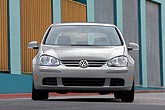Recent Articles
Popular Makes
Body Types
2006 Volkswagen Rabbit First Drive
The Rabbit Runs Again
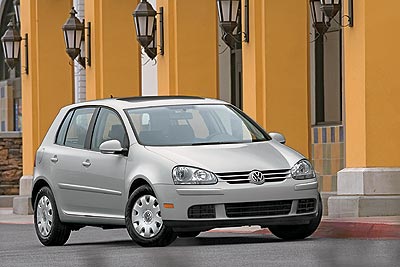
Volkswagen Rabbit – First Drive: is a German expression for small on the outside and big on the inside, and it’s how VW describes the 2006 Volkswagen Rabbit, which returns this summer as an all-new, fifth-generation replacement for the venerable Golf. With this new car and revived nameplate, VW is hoping customers will get all warm and fuzzy for the old Rabbit and subsequently judge the new model to be a fun, high-value, entry-level compact like the original. Initially engineered for the constricted and speedy streets of Europe, and first shipped across the pond in 1975, the Rabbit sold more than 1.3 million units in the U.S. during its hey-day after American buyers grew to appreciate its nimble handling, versatile packaging and fuel efficiency. Kerri Martin, Volkswagen’s Director of Brand Innovation and the woman behind the return of the Rabbit, is responsible for another recent and successful nameplate revival in the United States; she previously served as a BMW marketing manager and reintroduced the Mini brand to Americans. “The Rabbit was always exclusive to the U.S. and Canadian markets; while the rest of the world had the Golf, we had the iconic Rabbit,” said Martin. “The reintroduction of the Rabbit represents Volkswagen’s commitment to this market and is a nod to the passionate North American enthusiasts who have an emotional connection with the Rabbit name.” Though retaining the title of Golf throughout the rest of the world, the fifth-generation Rabbit destined for North America will be built in Volkswagen’s Wolfsburg, Germany, facility along with the recently introduced GTI, a performance-oriented Golf/Rabbit. Part of VW’s marketing plan is to stress the revived Rabbit nameplate as a unique, German-engineered model in a market segment that is gaining momentum in America, thus distancing it from competitors like the Dodge Caliber, Ford Focus ZX3 and ZX5, Mazda 3, Pontiac Vibe, and Toyota Matrix. On sale now, and boosted by 30 percent more horsepower than the old Golf, the new Volkswagen Rabbit is slightly taller, longer and wider than before and conforms to California’s stringent PZEV (Partial Zero Emissions Vehicle) regulations. Three-door versions will start at $15,620, while five-door models will start at $17,620 (including the $630 destination charge). VW expects fully-loaded versions to top out around $20,000, and hopes to sell between 10,000 and 12,000 Rabbits during the upcoming model year.
Model Mix
Model Mix Choose between three- and five-door models in a single level of trim. The standard equipment list is generous, especially for the five-door model. The new 2006 Volkswagen Rabbit in your choice between a three- or five-door hatchback equipped with a single level of trim, priced a couple thousand dollars higher than some competitors. In the future, it is possible that the Rabbit might be offered in TDI turbodiesel or 2.0T turbocharged guise, but for now just the Rabbit 2.5 comprises the lineup. The GTI is based on the Rabbit, but is considered to be a separate model. Notable standard equipment for every Volkswagen Rabbit includes air conditioning; cruise control; power windows/locks/mirrors; a telescopic steering wheel; side impact and side curtain airbags; and four-wheel-disc brakes with ABS, EBD, and brake assist. Added standard features include a five-cylinder gasoline-powered engine, five-speed manual transmission, dual chrome exhaust tips, green-tinted glass, 15-inch steel wheels with 195/65 tires, a driver’s-side one-touch power window, manually-adjustable front seats, and a 60/40 split rear seat. Five-door Rabbits add body-color exterior moldings, windshield washer nozzles, a cooled front storage compartment, floor mats, two interior reading lights, a six-disc in-dash CD changer, added front seat adjustment with a power reclining driver’s seat, heated front seats with lumbar support, a fold-flat front passenger’s seat, velour seating material, a rear-seat center armrest/pass through, more interior storage pockets, and rear seat climate vents. Options for both Rabbits include a six-speed Tiptronic automatic transmission, 16-inch alloy wheels with 205/55 tires, and stability control. Five-door models maintain exclusive rights to a power glass sunroof, XM or Sirius satellite radio and rear side-impact airbags.
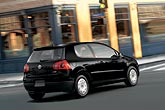
Nuts and Bolts
Nuts and Bolts The standard 2.5-liter inline five-cylinder engine makes 150 horsepower but boasts a broad torque band, making it feel lively underfoot. We averaged 19.4 mpg in the city, less than the EPA’s 22-mpg estimate. Essentially a Jetta with a hatchback body, the Volkswagen Rabbit shares many of its mechanical attributes with the Jetta 2.5 sedan. The same 2.5-liter inline five-cylinder engine makes 150 horsepower and 170 lb.-ft. of torque, with 90 percent of its motivating force available between 1,700 and 5,000 rpm. An optional six-speed automatic includes “normal” and “sport” modes, along with Tiptronic manual control. Fully independent suspension and four-wheel disc brakes with ABS/EBD and brake assist mesh with variable electro-mechanical rack-and-pinion steering to yield a traditional Germanic feel. Anti-Slip Regulation (traction control), Electronic Differential Lock and Engine Braking Assist are all standard. Electronic Stabilization Program (stability control) is optional on both models. Weighing between 2,974 and 3,173 lbs, depending on the transmission choice and number of doors, Rabbits save a few hundred pounds over their Jetta counterparts, subsequently giving them hare-like agility while potentially increasing fuel efficiency. VW reports that the Rabbit’s EPA fuel economy ratings are 22 city and 30 highway mpg. However, over the course of 68.3 spirited city miles, we observed a disappointing 19.4 mpg.
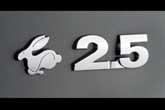
Design
Design The new Rabbit gets a clean interior design constructed of quality materials. Cargo capacity is 46 cubic feet with the rear seats folded down. The 2006 VW Rabbit distinguishes itself from its family members by eschewing the oversized chrome grille that decorates other Volkswagens. Executed with a convincingly articulated bumper, grille and lower fascia in body-color trim, Rabbit’s lack of a prominent Audi-like nose seems almost refreshing. Thick D-pillars and body-color lower moldings on the five-door models create a solid slab of sheetmetal that maintains the Rabbit’s coveted European flair. Teardrop-shaped taillights sit high in the rear quarters, looking great with the hatch open or closed. A cleanly styled interior takes advantage of Volkswagen’s long touted cabin-building competence. Fit-and-finish is impressive for a $15,000 vehicle, and of particular note are the Audi-quality gauges and controls. Other materials, such as the laminated visor and hard plastic door inserts, appear less than top-drawer. We appreciated the Rabbit’s large glove box, but would also opt for expanded and more creative stowage in the center console, as well as taller cupholders to fully secure many of today’s larger drinks. Both the three- and five-door models carry 15 cu.-ft. of cargo behind the rear seats. Cargo capacity expands to 46 cu.-ft. when the rear seats are folded. The need to carry longer gear is accommodated by a smart rear seat pass-through and a folding front passenger’s seat on the five-door version. Comparatively, Dodge’s Caliber swallows 18.5 cu.-ft. with the seats up, Ford’s three- and five-door Focus hatchbacks tackle 17.6 cu.-ft., and Toyota’s Matrix manages 21.8 cu.-ft.
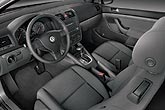
Safety
Safety Standard equipment for the new Rabbit includes six airbags, traction control, and a braking system with ABS, EBD, and brake assist. Options include stability control and side-impact airbags for the rear seat. A comprehensive safety system is responsible for the 2006 Volkswagen Rabbit’s four-star frontal and five-star side-impact rankings in the NHTSA’s crash-testing. Dual front airbags, front side-impact airbags, and side curtain airbags are standard. The five-door Rabbit is available with optional rear-seat side airbags – a unique offering in this class of vehicle. Active front seat head restraints help to properly position passengers during an impact, and the tilt/telescopic steering wheel maintains the proper distance between the driver and the steering wheel’s airbag. A brake pad wear indicator and an optional tire pressure monitoring system are also included on every Rabbit. The Rabbit’s six standard airbags, coupled with its standard traction control and available stability control systems, represent a significant gain in safety equipment over the first generation model. Rabbits are also protected by VW’s anti-theft system, with an alarm linked to the doors, hood and rear trunk that is designed to immobilize the engine when someone enters the car without the key. A laser-welded steel frame with anti-intrusion side door beams also add increased protection during a collision, while providing improved rigidity for better driving dynamics and handling response.
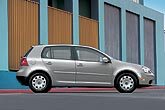
Driving Impressions
Driving Impressions Like any good German car, the 2006 VW Rabbit is solid on the highway, nimble in the city, quite comfortable, and genuinely fun to drive. We drove the 2006 Volkswagen Rabbit five-door for 200 miles, trying both the manual and the automatic transmissions. Due to heavy rains and flooding on the two-lane roads VW originally planned for the test drive, we were relegated to freeway and congested city motoring and were not able to truly stretch the Rabbit’s legs in a more rural setting. While the Rabbit’s acceleration time to 60 mph is a somewhat laggard nine seconds for the manual and a tick over that for the automatic, this car is no tortoise. It feels torquey off the line and when nosing to get past taxis and buses, but is mannerly in its quest to gain speed rather than rev-happy. The manual gearbox is tight and guides between gears with little effort. We enjoyed manipulating the Tiptronic automatic, and found an appreciable difference between “sport” and “normal” settings, preferring the higher-revving boost of the former. While Tiptronic’s response to manual input is not as crisp as some others we’ve driven, we did appreciate its fun-factor. The Rabbit’s engine and exhaust notes are pleasant and non-intrusive, a perfect fit for its around-town mission. The Rabbit’s five-cylinder engine is unique in its class, as competitors use four-cylinder motors. An output of 150 horsepower is unimpressive given the engine’s 2.5 liters of displacement and extra cylinder. The five-speed manual is competitive for the class and the six-speed automatic is advanced, although Dodge offers a continuously variable transmission (CVT) in the Caliber. Also worth noting: despite its weight advantage over the Jetta, the Rabbit is heavy compared to its competition, save the Caliber. Fuel economy suffers because of this, but the added weight, along with its rigid body structure, yields a better ride quality. Inside, the Rabbit’s cockpit is well-lit, with good visibility throughout and decent outside mirrors. Doors open wide to allow easy access to the front and rear seats on the five-door Rabbit we drove, but we would strongly discourage more than four travelers for any lengthy distance. Manual height-adjusting front seats are outdated and cranking them made us cranky, but the chairs are comfortable and well bolstered. It remains to be seen whether the new Rabbit will find a faithful following. It garnered little attention during our city drive, a solo rabbit badge at the back end proclaiming that the car was new, and because of its evolutionary design the Rabbit likely passed as a VW Golf for most who bothered to take a second look. But one thing’s for sure; this is the best Golf…er, Rabbit, yet.

FAQs
FAQs The Volkswagen Rabbit’s main competitors are the Chevrolet HHR, Chrysler PT Cruiser, Dodge Caliber, Ford Focus, Honda Fit, Kia Spectra5, Mazda 3, MINI Cooper, Nissan Versa, Scion xB, Pontiac Vibe, Suzuki SX4, Toyota Matrix, and Toyota Yaris. What is the new Volkswagen Rabbit and when is it on sale? On sale at the end of June, the 2006 Rabbit is VW’s replacement for the Golf. It is longer, taller and wider than its predecessor, with 30 percent greater horsepower. What vehicles should I cross-shop when considering a Volkswagen Rabbit? We would suggest you compare the 2006 VW Rabbit to the: Chevrolet HHR, Chrysler PT Cruiser, Dodge Caliber, Ford Focus, Honda Fit, Hyundai Elantra, Kia Spectra5, Mazda 3, Mini Cooper, Nissan Versa, Scion xB, Pontiac Vibe, Suzuki SX4, Toyota Matrix, Toyota Yaris What are the Volkswagen Rabbit’s best features? We doubt the Rabbit name is iconic to today’s younger generation, the one VW needs to court with this car, but the overall package is affordable and attractive, with entertaining German driving characteristics.
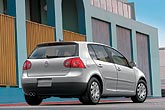
Specifications
Specifications Volkswagen says the Rabbit gets a four-star frontal and five-star side-impact crash-test rating from the NHTSA. Test Vehicle: 2006 Volkswagen Rabbit five-door Base Price: $17,620 (including the $630 destination charge) Engine Size and Type: 2.5-liter inline five-cylinder Engine Horsepower: 150 at 5,000 rpm Engine Torque: 170 lb.-ft. at 3,750 rpm Transmission: Five-speed manual (standard); six-speed automatic (optional) Curb weight, lbs.: 3,071 (manual); 3,173 (automatic) EPA Fuel Economy (city/highway): 22/30 mpg (both transmissions) Observed Fuel Economy: 19.4 mpg Wheelbase: 101.5 inches Length: 165.8 inches Width: 69.3 inches Height: 58.2 inches Head room (front/rear): 39.3/38.5 inches Leg room (front/rear): 41.2/35.3 inches Max. Seating Capacity: Five Max. Cargo Volume: 15 cu.-ft. (behind rear seats); 46 cu.-ft. Competitors: Chevrolet HHR Chrysler PT Cruiser Dodge Caliber Ford Focus Honda Fit Hyundai Elantra Kia Spectra5 Mazda 3 Mini Cooper Nissan Versa Scion xB Pontiac Vibe Suzuki SX4 Toyota Matrix Toyota Yaris
Photos courtesy of Volkswagen
